
views
- Store ripe tomatoes at room temperature on your counter for up to 1 week.
- Alternatively, store tomatoes in the fridge for up to 2 weeks.
- For longer storage, place tomatoes in a storage bin, then store them in a cool, dark place for up to 6 months.
Storing Tomatoes at Room Temperature

Use green tomatoes or a tomato bred for long storage. If you want to store tomatoes at room temperature for more than a week or so, you need to start with the right kind of tomato. Pick a variety of tomato meant for long storage, such as a Long Keeper Winter Storage tomato. These varieties are heartier and stand up to long storage better. You can use any variety tomato if it's still green, and it will ripen as it sits in storage.
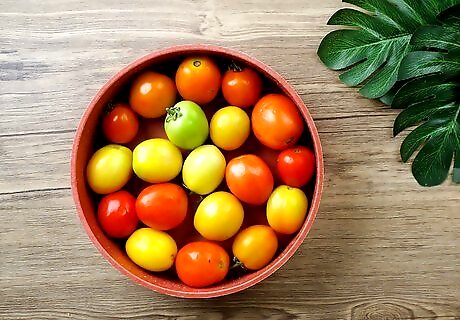
Place dry, unwashed tomatoes in a storage bin. You can use several different methods to store the tomatoes. One method is to simply layer them in a box or basket, then put newspaper between that layer and the next one. You can also store them in a box that canning jars came in, which should have separated spaces for each tomato. Alternatively, use an apple box with individual paper wrappers or make a small newspaper wrapper for each tomato. Close the box or cover it with a sheet to keep light out.
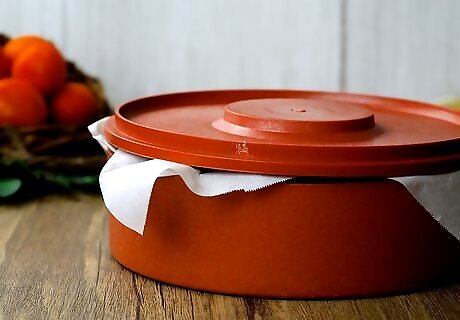
Store the tomatoes in a cool, dark area for up to 6 months. Put them in a basement or cellar to keep them cool. Alternatively, put them in the bottom of a closet or in another area that's not used much. Keep them out of direct sunlight.

Check your tomatoes for mold and signs of rotting at least once a week. If any of your tomatoes start to rot, it can spoil all the other tomatoes. Examine each one to ensure it's not rotting. Turn them while you're examining them, as they'll get riper where they're touching the box or basket. Remove any rotten tomatoes.

Ripen tomatoes in a warm spot for 1-2 days as needed. When you want to use a tomato, bring it out to a warm, sunny location to ripen for a day or two. Use one that already has some red in it; leave the greener ones to ripen more in the box.
Drying Tomatoes
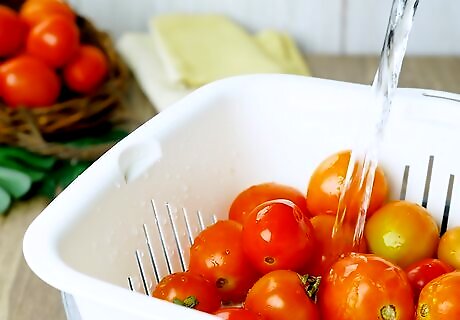
Wash the tomatoes before slicing them in half. Use your fingers to rub the tomatoes clean. With a very sharp knife, slice the tomatoes in half top to bottom. You can also use a serrated knife.
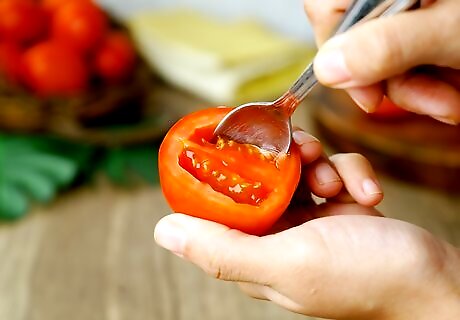
Remove the seeds and stem. With a sharp paring knife, cut out the stem and the brown part where the stem connects to the tomato. Use your fingers to scoop out as many seeds as you can. You don't need to remove every seed, but they will be extra crunchy when dried. You can also peel off the skins if you'd like.
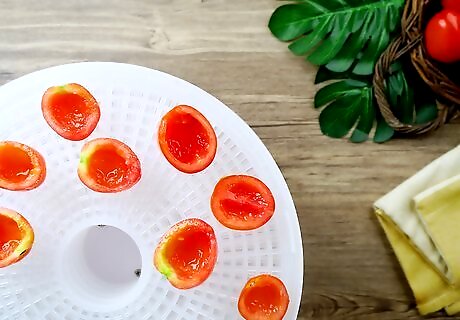
Lay the tomatoes on a dehydrator tray cut-side up. If you place the tomatoes cut-side down, they may stick to the tray, making them difficult to turn. Pack them in close together, as they will reduce in size by quite a bit. If you don't have a dehydrator, place your tomatoes on a baking sheet to go in the oven.
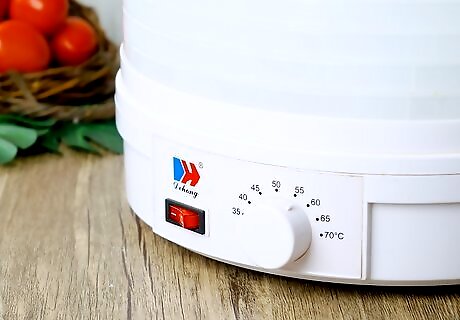
Dehydrate the tomatoes at 135 °F (57 °C). Set the tray in the dehydrator, and turn it on. Let the tomatoes dehydrate at this temperature for about 4 hours before checking on them. If you're drying the tomatoes in the oven, set the temperature at 150 °F (66 °C). Use an oven thermometer to make sure the tomatoes stay at this temperature.
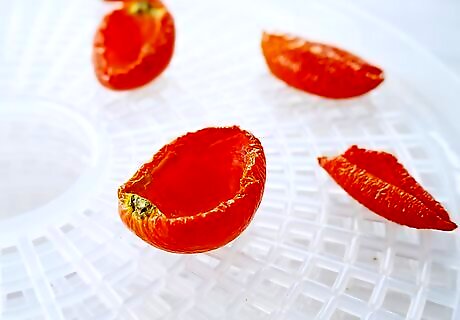
Turn the tomatoes after 3-4 hours. Use a spatula to flip the tomatoes over. Also, turn the trays around the other direction, as most dehydrators and ovens do not cook evenly across the whole space. Turn the tomatoes every hour or so after you do it the first time.
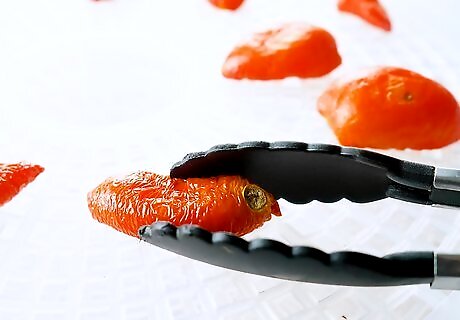
Remove the tomatoes as they dry to a leather-like texture. When you turn your tomatoes, check to see if any are dry. They should be soft and bendable, but not so dry that they're brittle. When done, the tomatoes shouldn't feel sticky at all, nor should they squish out any moisture when you squeeze them. If any tomatoes get too crispy, you can grind them up for tomato powder instead. Mix the powder with water to make tomato paste!
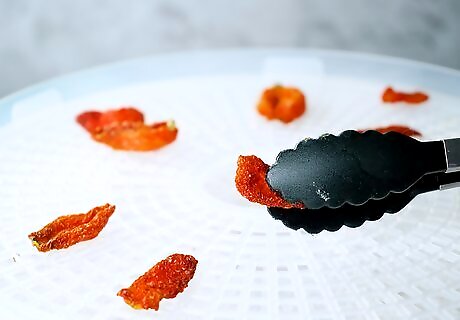
Continue checking on the tomatoes every hour or so up to 24 hours. While most tomatoes will finish in 6-8 hours, it depends on how big your tomatoes are and their moisture content. Look in on your tomatoes every hour or so to check for the dry ones.
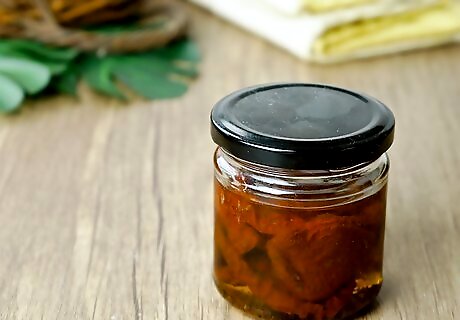
Keep the tomatoes in oil or freeze for up to a year. To store the tomatoes in the refrigerator or freezer, place them in a zip-top bag and squeeze any extra air out. Put them in the refrigerator for up to a month or stick them in the freezer. To store tomatoes in oil, sterilize a mason jar by boiling it for 10 minutes. Let the jar dry. Dip the tomatoes in red wine vinegar, then add the tomatoes to the jar. Pour oil (such as olive oil) over the tomatoes until they are completely submerged. Keep the jar in a cool, dark place. When taking tomatoes out, make sure the remaining tomatoes are still submerged in the oil.
Freezing Tomatoes

Wash the tomatoes and cut the stem scar out. Run the tomatoes under fresh water. Rub them with your fingers to remove any excess dirt. Use a paring knife to remove the stem scar, the brown spot left behind where the stem was removed. It's best to use running water. Washing the tomatoes in standing water increases the chances of bacteria entering the tomato through the stem scar.
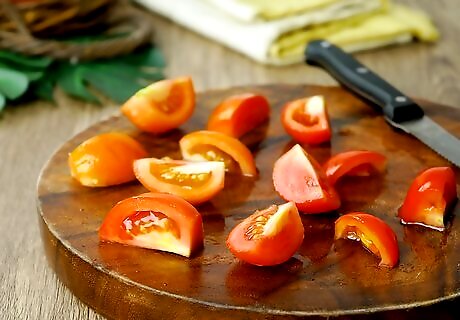
Cut tomatoes into pieces if you want to use small amounts later. Cut the tomatoes into quarters or halves using a paring knife. That way, you can take part of a tomato out of the freezer if you need it later. You can freeze small tomatoes whole if you prefer.
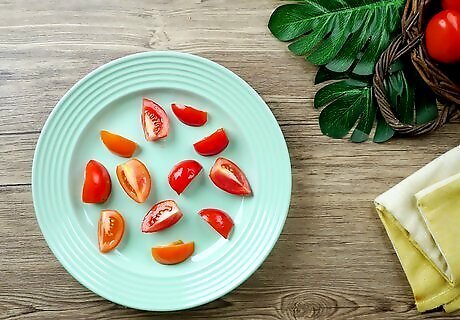
Place the tomatoes pieces on a plate or tray in a single layer. Don't pack the tomatoes in too closely at this point, as they may stick together. Put the tomatoes in the freezer until they are solid ice, then use your hands to break them up into the original chunks you cut. If you're using whole tomatoes, you can skip this step.

Store the tomatoes in an airtight container in the freezer for up to a year. Stack the tomatoes into the container. If you're using a zip-top bag, squeeze out as much air as possible. If you're using whole tomatoes, just stack them together in the container. They'll still come apart after they're frozen.
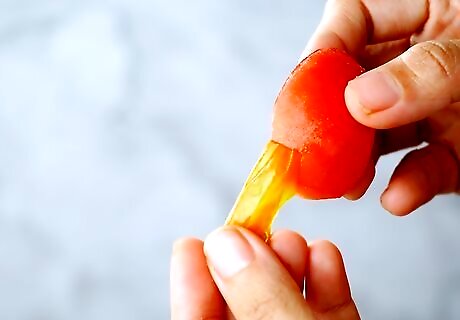
Peel the skins off after freezing the tomatoes, if desired. One bonus of freezing tomatoes is the skins peel off with ease. Once you take the tomatoes out of the freezer, use your fingers to pull off the skins.
Canning Tomatoes
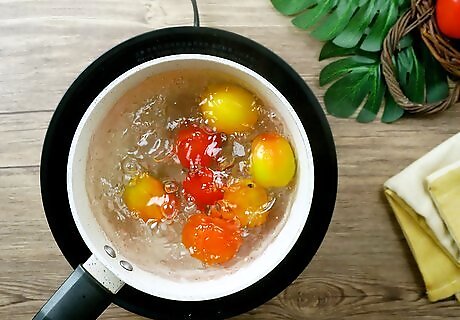
Wash and blanch the tomatoes. Run the tomatoes under fresh water, using your fingers to rub them down. With a paring knife, make a small X on the bottom of each tomato. Dip the tomatoes in boiling water a couple at a time for about half a minute. Wait until you see the skins start to lift off before plunging them into ice water. Move them to a towel to finish cooling.
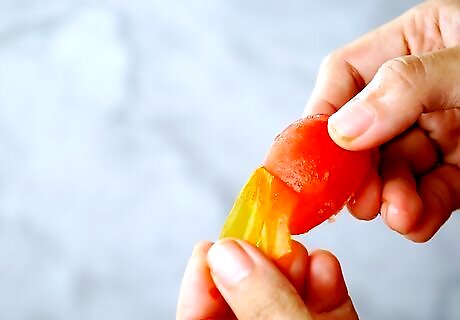
Peel the tomatoes and remove the seeds and excess juice. Use your fingers to pull the skins off the tomatoes, and place them in a strainer over a pan. Remove the brown stem area with a paring knife. Cut the tomato in half. Scoop the seeds out with your fingers into the same colander with the tomato skins. Let any extra juice pour into the strainer, too. Once you've skinned all the tomatoes, smash the seeds and skins with a spatula over the colander, producing more tomato juice and water.
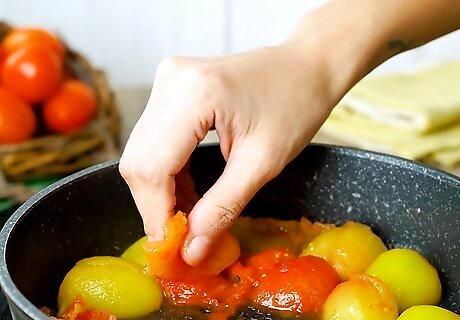
Squish the tomato pulp with your fingers. Crush the rest of the tomato into large pieces over a pan. If you still have large chunks in the pan, use a potato masher to break them up more.
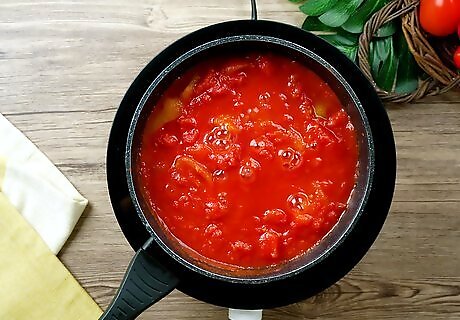
Cook the tomatoes and the tomato water. Let the 2 pots, the one with tomatoes and the one with tomato water, come to a boil on the stove over medium-high heat. Reduce the heat to low, and let the pots cook until the tomatoes start to break down. You can add herbs and spices before cooking the tomatoes if you'd like. Try minced garlic, onion, or peppers, Italian seasoning, salt and pepper, and/or fresh sprigs of basil or rosemary. You won't notice much of a difference in the tomato water as it cooks, but just cook it the same amount of time as the tomatoes.
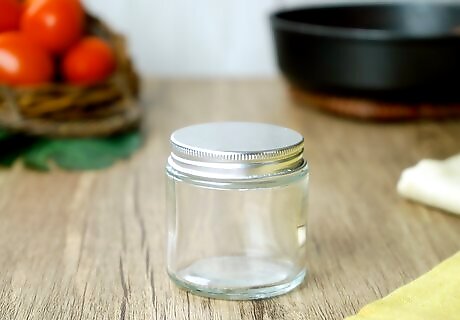
Sterilize the canning jars. While you're cooking the tomatoes, bring water to a boil in your pressure canner. Place the jars, lids, rings, ladle, funnel, and tongs in the water. Let them boil for a few minutes, and keep them in the water until you're ready to pour the tomatoes in. Pull the jar tongs out with another set of tongs and use the jar tongs to remove the jars from the hot water.
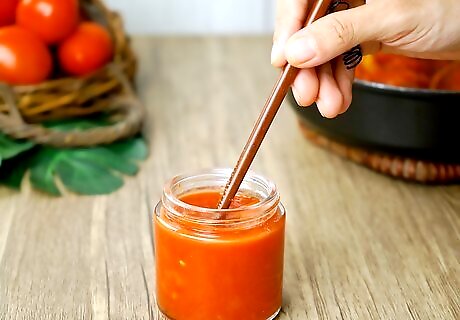
Pour the tomatoes into the jars and stir them to remove bubbles. Place a funnel on top of each jar, then ladle in enough tomatoes to fill the jar. Leave ⁄2 inch (1.3 cm) of room at the top. Run a clean knife or chopstick through the tomatoes in the jar to clear any bubbles. Use the same process for the tomato water, too.
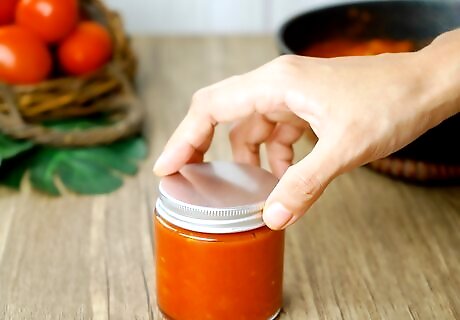
Put the lids on the jars after wiping the jars down. Clean the rims of the jars with a cloth so the lids will be able to seal. Place the lids on the jars, then screw on the rings. Set the jar in the pressure canner using the tongs.
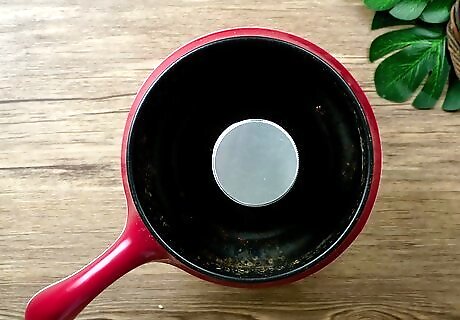
Can the jars with a pressure canner using 11 pounds (5.0 kg) of pressure. Place the lid on the pressure canner, and turn the burner to high heat. Watch for steam to come out the top. When it does, cook the jars for another 10 minutes, then use the valve to begin pressurizing the pot. Let it reach 11 pounds (5.0 kg) of pressure. Cook the tomatoes for 15 minutes at this pressure. Keep an eye on the pressure the whole time. It can go a little higher, but don't let it go below 11 pounds (5.0 kg). If it does, increase the pressure and cook it another 15 minutes. Don't try to can tomatoes using the water method, as they aren't quite acidic enough, meaning you can end up with botulism!
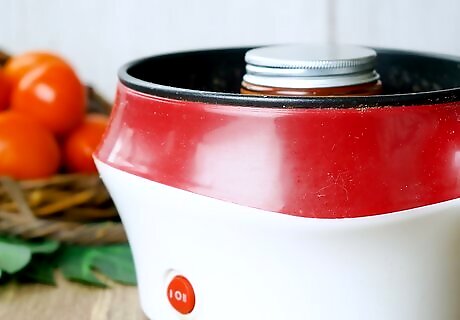
Let the pressure canner come to room temperature. Turn the burner off. Once the pressure canner has cooled down and released pressure, watch for the cover lock to drop. Open the pressure canner carefully, and use your tongs to take the jars out of the pot.
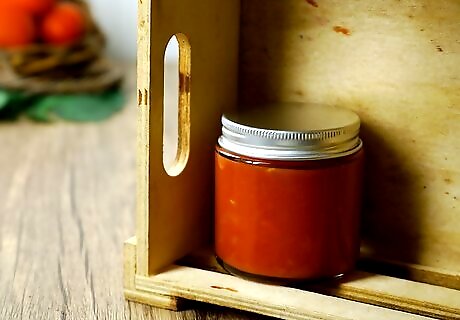
Test the jar lids and store your tomatoes for up to a year. When the jars have cooled for a few hours and you've checked that the lids have popped in, take the rings off carefully. Hold the jar by the lid for a moment to see if it gives at all. If it does, put it in the refrigerator and use it soon or can it again. Place the sealed jars in a cool, dark area. Use the crushed tomatoes in stews, soups, and sauces. Add the tomato water to soups like broth. You can remove the jar bands for storage. If you leave them on, they can rust over time.


















Comments
0 comment